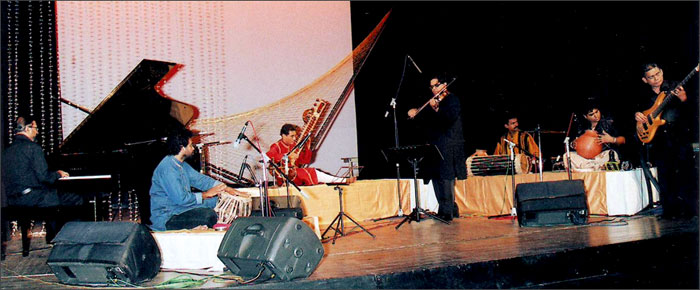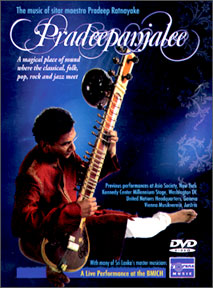|
Pradeepanjalee 14 - featured the best of the best:
Evening of bliss
Indeewara Thilakarathne and Ranga Chandrarathne
|

Pradeep Ratnayake on sitar accompanied by Harsha Makalanda
on piano, Lakshman Joseph de Saram on violin,
Chandralal Amarakoon on tabla along with other musicians. |
"Music is the mediator between the spiritual and the sensual life." -
Ludwig van Beethoven.
Perhaps these immortal lines were amply manifested in no uncertain
terms when the curtain rose the other day at the Lionel Wendt theatre as
14th Pradeepanjalee got under way. More than anything else, it was the
attentive audience which made the performance a memorable occasion.
Fusion
Though the fourteenth concert was marked for its brevity, it was not
without Pradeep's signature innovative fusion music, a mighty
amalgamation of diverse traditions of music. The stallions on diverse
instruments are the best of the best among their instruments of
expertise and traditions.
 Traditions as diverse as possible from the East and the West worlds
of music were painstakingly fused to render a divine element to the
performance. It was not a mere fusion or on-the-stage improvisation, but
a well-crafted pre-determined pieces of music. Traditions as diverse as possible from the East and the West worlds
of music were painstakingly fused to render a divine element to the
performance. It was not a mere fusion or on-the-stage improvisation, but
a well-crafted pre-determined pieces of music.
Throughout his trailblazing series of concerts, Pradeep kept the
flame alive by adding innovative pieces of fusion music, besides his
favourite items in the concert such as Flight.
It is this characteristic that enlivens the performance and keeps the
audience in expectation in a spell of music which has set precedence in
Sri Lankan music scene dominated by popular music.
Through the fusion and innovative music, Pradeep Ratnayake has
created a distinct Sri Lankan identity not only in Sitar but also in his
masterpieces such as "Indrakeelaya", a tone poem composed for the
occasion of the 50th Anniversary of the Central Bank of Sri Lanka in
1999.
Having studied in the University of Visva Bharati and established in
the famed school of Maihar Gharana, the same tradition which nourished
the music legend of Ravi Shankar, his voyage into the realms of
innovative fusion music carried him to the prestigious venues such as
Asia Society (New York), United Nations Office (Geneva), Walt Disney
Theatre (Los Angeles), Kennedy Center Millennium Stage (Washington DC)
and Vienna Musikverein (Vienna).
Traditionally, the Pradeepanjalee concert is commenced with a Raga in
North Indian classic. For this concert, Pradeep had chosen the Rag Yaman
as a tribute to the tradition which created him.
He played the basic features of the Raga; Alap (a free
improvisation), Jode Alap and Jala (the zenith of the Alap) and Gath in
Three Tal commenced in slow tempo (Vilambitlaya) and developed into
medium tempo (Mahdyalaya) and the fast tempo (Drutalaya). Significantly,
Pradeep played the Rag according to the Maihar Gharana style. The Rag
Yaman creates a mood of devotion and spirituality.
The next item "Stallion in the Field " (Sitar, Violin, Piano, Bass
Guitar, Getabera, Ghatam, Tabla and Udakki) is based on traditional
Thuranga Vannama and is played with five beat rhythm. The composition
captures the essence of movements of restless horses in the field, their
energy and grace. In addition to traditional elements from Thuranga
Vannama, Pradeep has used elements from Jazz for the composition which
was played by Harsha Makalanda on piano.
Traditions
Western Classical elements are brought into the composition by
Lakshman Joseph de Saram on violin while Alston Joachim played the Bass
Guitar according to Jazz and popular music styles. Pradeep played Sitar
in Hindustani and Sri Lankan traditions.
The composition is marked for its sheer fusion of traditions. For
instance, Harsha Makalanda who is one of the best pianists in the Jazz
tradition and Lakshman Joseph de Saram, a music genius who played violin
since 13, have been steeped into the Western classical music, have added
their distinctive shades to the tapestry of composition.
For, it is indeed an assembly of rare traditions of music in a
composition with unique signature of Pradeep.
Piano Raga is based on the Indian Raga Abhogi (Sitar, Violin, Tabla).
Here in this composition, Pradeep has exploited the common elements in
Indian Raga and Jazz traditions of music which is the improvisation.
However, in the Jazz tradition improvisation is done according to a set
of chords. In Indian music, it is only a melody.
Here Harsha answered the Rag played by Pradeep on sitar. One of the
techniques practiced in the piece is the change of scales. For instance,
scale was shifted from D minor to C Minor scale.
This is done without distorting the primary characteristics of Raga.
Harsha Makalanda accompanied the composition in Jazz style and Pradeep
introduced the Blues scale to the Raga. As Blues in chromatic style, it
is very difficult to play on sitar. The Winds from Home is a composition
steeped in folk music (Sitar, Flute, Ghatam, Tabla and Ganjira). For
this composition, Pradeep has extensively derived elements from Indian
folk melodies.
However, Pradeep has not borrowed Indian melodies but beautified his
creation with some elements from them. This is one of the unique
compositions which brings out the air of fields and harvest with the
sublime merriment associated with it. Khole, a West Bengalian folk music
instrument, Ghatam, a North Indian instrument have also been used to add
allure of folk elements in the tradition of North Indian and Bengali
folk music.
Flight
|

Prof J. B. Dissanayake lighting the ceremonial oil lamp watched
by Messrs Sarath Kotalawela, HNB Assurance Managing Director
Manjula de Silva, HNB Chairman Rienzie Wijetileke and Prof Carlo
Fonseka. |
The last item " Flight" depicts the powerful movements of a hawk as
it glides and soars through the sky. It is one of the favourites in the
Pradeepanjalee series which is based on traditional Ukusa Vannama.
Though it is purely based Sri Lankan traditional music, other
elements such as those from Jazz, rock, Western and Indian classical
music have also been used for the creation.
Special attention has been paid to the solo instruments Gataberaya,
Udakki and Tammatama with a Sri Lankan identity.
A technique such as Sawal Jawap (question and answer, traditionally
played between sitar and tabla) has been, for the first time, used on
sitar and gataberaya. Jawari Sangat is another technique which has also
been used in the composition. It is a technique whereby two instruments
are being played simultaneously. This is being practiced with Beraya.
All in all, the concert offered a memorable experience which was only
scarred by poor compering.
****
One of the highlights of the 14th Pradeepanjalee was the launch of
the DVD containing 'pure music', for the first time in Sri Lanka.
The DVD produced by Torana Music was presented to Rienzie Wijetileke,
chairman of Hatton National Bank and HNB Assurance which sponsored the
concert. This is the first ever DVD of 'pure music' recorded in Dolby
Digital sound. It is marked for its variety of elements of music from
almost all traditions of music such as Jazz, Blues, Rock and even
popular music.
The DVD also contains items in the Sithijaya CD and items Pradeep
played at the concert held at the Walt Disney Theatre. The music of the
DVD is made up of Sri Lankan folk, Indian Folk, North Indian Classical,
South Indian Classical and Blues, Jazz and Rock elements of music.
***
Perhaps, Rag Pilu originally played by Pandit Ravi Shankar and the
Violinist Yehudi Menuhin and won the Ravi Shankar's first Grammy Award
for the album " East Meets The West" in 1957, was the cynosure of the
performance.
The piece was described by Prof. Carlo Fonseka as "Yehudi Menuhin
couldn't have done better" in the presence of us and maestro Lakshman
Joseph de Saram who played the violin in the piece to the spellbound
audience.
The original composition was played by Pandit Ravi Shankar on sitar,
Yehudi Menuhin on violin and Ustard Alla Rakha on tabla. In the concert,
the piece was played by Pradeep Ratnayake on sitar, Lakshman Joseph de
Saram on violin and Chandralal Amarakoon on tabla.
This piece was one of the most difficult pieces as it was originally
played by Pandit Ravi Shankar who is also from the Maihar Gharana. Ravi
Shankar played piece composed by him based on Rag music, within the Rag
framework with Yehudi Menuhin who was steeped in western classical music
tradition. Menuhin was not conversant with the North Indian Classical
music.
So he played the piece according to western tradition while Ravi
Shankar played it in his own tradition. It was a meeting of traditions.
Reason for the inclusion of this piece is that Pradeep played it within
the traditional framework. A significant aspect of the piece was that
the violin was played in pure Western style. |

